India Group Tour Packages
Discover the India Group Tour Packages, including the captivating Golden Triangle Tour with Varanasi, Orchha, and Khajuraho. This extraordinary journey seamlessly combines the allure of India's most iconic destinations with the enchanting beauty and spirituality of Varanasi, the historical charm of Orchha, and the intricate artistry of Khajuraho. Providing a comprehensive experience of India's rich history, culture, and spirituality, this tour allows travelers to delve into captivating history, spirituality, and artistry while exploring some of the country's most iconic destinations. Each place on this journey offers a unique facet of India's rich cultural tapestry, making it a memorable and culturally enriching adventure.
Travocation Group offers wide ranges of Golden Triangle tours for an unforgettable trip to India.
was $1,154.00
save upto 20 %
Book Now
About This Tour

Free cancellation
Cancel up to 24 hours in advance for a full refund

Reserve now & pay on arrival
Keep your travel plans flexible — book your spot and pay nothing today.

Covid-19 precautions
Special health and safety measures are in place. Check your activity voucher once you book for full details.

Duration 08 Days
Check availability to see starting times.

Skip the line through a separate entrance

Live tour guide
English, Spanish, Japanese, French, Russian, German, & More

Pickup included
Pick up from Delhi airport, your hotel in Delhi Or Gurgaon

Private Tour
Highlights
- Explore the Historic sites of Delhi like Jama Masjid, Humayun’s Tomb & India Gate.
- Enjoy the Rickshaw ride in the narrow lanes of Delhi.
- Visit the UNESCO Buddhist site in Sarnath.
- Explore the Ghats on the bank of River Ganges in Varanasi
- Witness the evening Aarti on the bank of River Ganges.
- Visit the beautiful Fort, Palaces & Temples in Orchha.
- Explore the majestic Agra Fort & the ghost city Fatehpur Sikri with its rich Mughal architecture.
- Witness the iconic Taj Mahal at sunrise, a UNESCO World Heritage Site.
- Experience the chaotic markets of Jaipur.
- Visit the beautiful Monkey Temple in Jaipur.
- Witness the biggest sundial in an astronomical observatory in Jaipur.
What’s Included
- Pickup and drop back to hotel / airport in New Delhi
- Elephant ride in Jaipur ( If Option Chosen )
- Experience the chaotic markets of Jaipur.
- 09 Nights 03 Or 05 Star accommodation, Single/Dbl Occupancy Bed / Breakfast / Taxes ( If Option Chosen )
- Accompanying Professional Tour Guide in your Language
- All Entrance / Monuments Tickets fees ( If Option Chosen )
- 02 flights Khajuraho to Varanasi - Varanasi to Delhi
- All Taxes – express highway toll, airport parking, Monument parking charges, fuel and state taxes
- Boat Ride in Varanasi ( If Option Chosen )
- Rickshaw ride in Delhi ( If Option Chosen )
- Tip to Tour Guide & Chauffeur
- Lunch and Dinner at restaurant or at hotel
Detailed Itinerary
Expand allCollapse allArrival & Explore Delhi
This tour starts with your pick up from the airport or any hotel in & around Delhi, Noida & Gurugram. Our Representative will be there to pick you up by private car. Your guided city will start with your visit to the following monuments of Delhi.
Delhi, the capital city of India, is a vibrant metropolis that seamlessly blends a rich historical heritage with the fast-paced dynamics of modern life. With a history dating back to ancient times, Delhi has been a witness to the rise and fall of numerous empires, leaving behind a tapestry of diverse cultures and architectural marvels.
The city is home to iconic landmarks such as the Jama Masjid, India Gate, and Qutub Minar, each narrating a chapter from India's past. The bustling streets of Old Delhi exude an old-world charm, with narrow lanes, bustling markets, and the aromatic waft of street food. In contrast, New Delhi, with its wide avenues and colonial-era architecture, serves as the seat of the Indian government.
Jama Masjid: It is one of the most iconic sites of Old Delhi. This grand mosque was erected in 17th century by 5th Mughal Emperor Shah Jahan when the Mughal capital was moved from Agra to Delhi. 25000 believers can offer prayer at one time in this mosque. This is a beautiful example of Indo Islamic architecture.
Spice Market: Old Delhi’s spice market is located in chandni chowk area is believed to be one of the oldest & biggest spice markets of Asia. A visit to this market is a must & to experience the busy streets & smell the essence of different spices. Enjoy the rickshaw ride to see the busy & narrow lanes of Old Delhi.
Raj Ghat: It is a cremation site of one of the most respected & renowned persons of the world, Mahatma Gandhi (The Great Soul Gandhi). He is a national hero & led many movements against the unlawful practices of British Raj in India before independence.
Humayun’s Tomb: It is believed to be the first garden Mausoleum of India which is the final resting place of 2nd Mughal Emperor Humayun. It was erected in 16th century by his widow Haji Bano Begam. The mausoleum is a beautiful example of fusion of Indo Islamic architecture. This grand mausoleum is standing in the middle of the char bagh Persian style of garden with water channels & fountains. This mausoleum complex is also known as ‘Dormitory of Mughals’ because it has around 150 tombs of the family members of Mughal Emperors.
India Gate: It is a war memorial which was erected in 20th century before independence to honour the martyrdom of 13000 soldiers who lost their lives in the First World War. This huge gateway with a height of 52 metres is built of sand stone & it is a symbol of India.
Bangla Sahib Gurudwara: It is a prominent Sikh house of worship in Delhi, is known for its serene sarovar (pool) and golden dome. Built in the 18th century, it commemorates Guru Har Krishan's stay. The gurudwara serves langar (free community meals) and embodies Sikh principles of selfless service and equality.
Qutub Minar: It is an iconic landmark in Delhi, India, stands as a testament to the capital's rich history. Constructed in the early 13th century by Qutub-ud-din Aibak and later expanded by his successors, this UNESCO World Heritage Site represents Indo-Islamic architecture. The towering minaret, reaching a height of 73 meters, boasts intricate Arabic inscriptions and ornate carvings. Surrounding it are historic structures such as the Quwwat-ul-Islam Mosque and the Iron Pillar. Qutub Minar narrates tales of Delhi's diverse cultural influences, from the Qutub complex's inception as a victory tower to its subsequent repurposing under different dynasties.
Lotus Temple: It is an architectural marvel shaped like a blooming lotus flower. Completed in 1986, it serves as the Bahá'í House of Worship, welcoming people of all faiths. The serene white marble structure stands as a symbol of unity, attracting visitors for its unique design and peaceful ambiance.
Post city tour, you will be drop off to your pre booked accommodation & relax.
You are staying this night in Delhi.
Driven from Delhi to Jaipur & Explore it
Post Breakfast, you will be driven to Jaipur. This journey takes 04- 05 hours with a stop at halfway for refreshments. Upon Arrival, check in to the Hotel & in the early evening you will go out & witness the aarti in the temple.
Birla Temple or Laxmi Narayan Temple: This beautiful temple was constructed in 1988 by the Birla Family, is dedicated to Lord Vishnu & Goddess Laxmi. This temple graces the skyline of Jaipur. Adorned with intricate carvings, it stands as a serene oasis of spirituality amidst the bustling city. Witness the evening aarti ceremony in the temple.
After visiting the temple, come back to the hotel & relax.
You are staying this night in Jaipur.
Jaipur City Tour
Jaipur, often referred to as the "Pink City," is the capital city of the Indian state of Rajasthan. It is known for its rich history, vibrant culture, and stunning architecture. Jaipur was founded in 1727 by Maharaja Sawai Jai Singh II, the ruler of Amber, who decided to build a new capital city. The city was meticulously planned with wide streets and organized blocks. Jaipur is a major tourist destination, attracting visitors from around the world. The combination of historical landmarks, cultural experiences, and vibrant markets makes it a must-visit city in India.
Post breakfast, start your city tour with professional tour guide & visit beautiful sites of Jaipur.
Amber Fort: This majestic fort located in Amer town surrounded with Aravali hills near Jaipur, Rajasthan, is a majestic fortification that echoes the opulence of Rajputana architecture. Built in the 16th century, it showcases a fusion of Hindu and Mughal styles. With ornate palaces, intricate carvings, and panoramic views, Amber Fort stands as a testament to India's regal heritage.
Panna Meena Kund: It is a historic step well near Amer Fort in Jaipur, is a symphony of ancient engineering and aesthetics. Built in the 16th century, its geometrically patterned steps and vibrant hues make it both functional and visually striking. The step well served as a communal gathering place and a source of water in the arid region.
Hawa Mahal or Palace of Winds: It stands as a mesmerizing architectural marvel in Jaipur. Built in 1799 by Maharaja Sawai Pratap Singh, its unique facade with 953 intricately designed windows allowed royal ladies to observe street festivities while maintaining privacy. This five-story honeycomb-like structure is a cultural gem.
Jal Mahal or the Water Palace: This palace is an enchanting architectural gem in the midst of Man Sagar Lake in Jaipur. Built in the 18th century, the palace appears to float on the lake's surface. With its red sandstone and intricate details, Jal Mahal is a captivating testament to Rajput style.
Jantar Mantar or the Observatory: It is an astronomical observatory in Jaipur, is a UNESCO World Heritage Site. Constructed in the early 18th century by Maharaja Sawai Jai Singh II, it houses a collection of architectural instruments for celestial observations. The site showcases the ingenuity of Indian astronomers and stands as a historic testament to scientific achievement.
City Palace: This is believed to be one of the 03 biggest palaces of any royal family in Jaipur. It is a splendid royal complex reflecting a fusion of Rajput, Mughal, and European architectural styles. Constructed by Maharaja Sawai Jai Singh II in the 18th century, it houses museums, courtyards, and palatial structures. The palace stands as a living testament to Jaipur's regal history and cultural richness.
There will be a stop for lunch & shopping in between the sightseeing of Jaipur.
Galta Ji Temple: This Temple is located amid the Aravalli Hills near Jaipur, is a sacred Hindu pilgrimage site also known as the Monkey Temple, it features ancient shrines, kunds (water tanks), and natural springs. The temple complex exudes a tranquil atmosphere, and its natural surroundings attract pilgrims and tourists seeking spiritual solace. In this temple complex, where you will see the human & monkeys takes bath in the same water reservoirs.
After seeing the beautiful sites of Jaipur, come back to the hotel & relax.
You are staying this night in Jaipur.
Driven from Jaipur to Agra
Post Breakfast, check out from hotel & driven to Agra. This journey takes 04 – 05 hours with a stop for lunch at halfway. Enroute stop at
Chand Baoli step well: This step well located in Abhaneri village near Jaipur, is an ancient step well dating back to the 9th century. With 3,500 symmetrical steps leading to the water level, it exemplifies intricate architecture. The well, surrounded by arched corridors, served as a water reservoir and a respite from the desert heat.
Fatehpur Sikri: It is a UNESCO World Heritage Site renowned for its exquisite Mughal architecture. Commissioned by Emperor Akbar in the late 16th century, the city served as the Mughal capital from 1571 to 1585. It is also known as a Ghost Town which has been abandoned since many centuries. This is also the place where the sufi mystic had forecasted the birth of a worldly heir Prince Salim. The site reflects a unique blend of Hindu and Islamic architectural styles, showcasing Akbar's vision of religious tolerance. Despite its short-lived prominence, Fatehpur Sikri remains a poignant symbol of Mughal splendor and cultural synthesis.
Continue driven to Agra, upon arrival in Agra, check inn to the pre booked accommodation & relax.
You are staying this night in Agra.
Agra City Tour
Agra, located in the northern state of Uttar Pradesh, India, has a rich and storied history that spans several millennia.Agra's history can be traced back to ancient times when it was known as "Agravana" or "Agrawana" in Sanskrit literature. It is believed to have been part of the ancient Brijbhumi region, associated with Lord Krishna.It gained prominence during the 16th century as the capital of the Mughal Empire under Emperor Akbar, who built the Agra Fort and initiated the construction of Fatehpur Sikri nearby.Agra has a rich cultural heritage that blends Mughal, Persian, and Indian influences. This heritage is reflected in its cuisine, art, and music, making it a vibrant and culturally significant destination.
Visit Monuments Like
Start your day early at sunrise to visit the Taj Mahal with professional tour guide. After visiting the Taj Mahal, come back to the hotel for breakfast.
Taj Mahal at Sunrise: It is believed to be one of the most beautiful examples of expressing love for a woman. This marble mausoleum was erected in 17th century by 5th Mughal Emperor Shah Jahan for his beloved wife Mumtaz Mahal who died after childbirth. It took 22 years to build. It is something that you must see once in a life as a person.
Agra Fort: The Majestic fort is believed to be the first fort erected by Mughal Emperor in 16th & 17th centuries in their first capital city Agra which was known as Akbarabad. This has huge ramparts, beautiful palaces in red sandstone & white marble, big halls of common & private audiences, Persian form gardens with water channels & fountains. This fort is not to be missed when you are in Agra.
Etimad ud Daulah or the Baby Taj: Often called the "Baby Taj," the Itimad-ud-Daulah's Tomb in Agra, is a masterpiece of Mughal architecture. Built in the 17th century by Nur Jahan for her father, it features intricate marble inlay work and serene gardens. This smaller-scale gem is considered a precursor to the grandeur of the Taj Mahal.
Mehtab Bagh or the Moon light Garden: This beautiful Moon Light garden located across the Yamuna River from the Taj Mahal in Agra, offers breathtaking views of the iconic monument. Built during the Mughal era, it is a charbagh (four-part garden) with lush greenery. The garden is an ideal spot to admire the Taj Mahal's beauty and capture stunning reflections at the sunset.
After visiting the sites of Agra, driven back to the pre booked accommodation & relax.
You are staying in Agra.
Driven from Agra to Orchha & Explore It
After having the luscious breakfast, you will be driven to your next destination i.e., Orchha. This journey takes 03 – 04 hours with a stop at halfway for refreshments. Upon arrival, check in to the hotel & later explore Orchha & it’s beautiful sites.
Orchha, a picturesque town nestled on the banks of the Betwa River in the heart of India, is a hidden gem that embodies the essence of India's rich history and architectural heritage. Orchha is also renowned for its chhatris or cenotaphs, which are elevated, dome-shaped memorials, dedicated to the Bundela rulers. These chhatris, set against the backdrop of the river, create a mesmerizing reflection during the golden hours of the day.
Post Lunch Visit the sites of Orchha
Orchha Fort: This majestic fort nestled on the banks of the Betwa River in Madhya Pradesh, is a captivating medieval marvel. Built in the 16th century by the Bundela Rajput kings, the fort boasts exquisite architecture, including the iconic Jahangir Mahal. Its intricate frescoes and historical significance make Orchha Fort a cultural gem.
Jahangir Palace: This is a splendid palace built in the 17th century for Emperor Jahangir within Orchha Fort. This architectural masterpiece reflects a blend of Mughal and Rajput styles, adorned with ornate domes, intricate carvings, and vibrant frescoes. Jahangir Mahal stands as a testament to the cultural fusion and artistic grandeur of its era.
Cenotaphs or Chhatri of Orchha: The Royal Cenotaphs of Orchha stand as silent tributes to the Bundela rulers of the 17th and 18th centuries. Perched along the serene Betwa River, these intricately carved cenotaphs, also known as Chhatris, commemorate the valor and grandeur of the departed kings and their families. The architectural splendor of these memorials, adorned with domes, spires, and delicate detailing, harmoniously integrates Rajput and Mughal influences. Each cenotaph reflects a unique design, contributing to Orchha's rich heritage.
After sightseeing, come back to the hotel & relax.
You are staying this night in Orchha.
Driven from Orchha to Khajuraho & Explore It
After having the luscious breakfast, you will be driven to your next destination i.e. Khajuraho. This journey takes 03 – 04 hours with a stop at halfway for refreshments. Upon arrival, check in to the hotel & later explore Khajuraho & it’s beautiful sites.
Khajuraho, located in the Indian state of Madhya Pradesh, is renowned for its exquisite group of temples, collectively known as the Khajuraho Group of Monuments. These temples are a UNESCO World Heritage Site and are celebrated for their stunning and intricate erotic sculptures, which are some of the most famous in the world. The history of Khajuraho is fascinating and dates back to the Chandela dynasty, which ruled over the region from the 9th to the 13th centuries.
Post Lunch, start guided city tour of Khajuraho & Visit
Eastern Group of Temples: The Eastern Group of Temples constitutes a remarkable ensemble of Hindu temples renowned for their architectural and sculptural brilliance. Constructed between the 9th and 12th centuries by the Chandela dynasty, these temples showcase exquisite craftsmanship and intricate carvings depicting various facets of life. Notable structures within the group include the Parsvanatha, Adinatha, and Ghantai Temples. These architectural marvels exemplify the rich cultural and artistic heritage of medieval India.
After sightseeing, come back to the hotel & relax.
You are staying this night in Khajuraho.
Fly from Khajuraho to Varanasi
Post breakfast start your city tour & explore western group of temples which are famous for their erotic carvings.
Western Group of Temples: The Western Group of Temples is a masterpiece of medieval temple architecture and a UNESCO World Heritage Site. Built by the Chandela dynasty between the 10th and 12th centuries, these temples exemplify the exquisite artistry of the time. The Kandariya Mahadeva, dedicated to Lord Shiva, stands as the largest and most ornate, adorned with intricately carved sculptures depicting divine deities, mythical creatures, and sensuous figures. Other prominent temples like Lakshmana and Vishvanatha contribute to the ensemble, showcasing the perfect fusion of spirituality and sensuality. The Western Group remains a testament to India's rich cultural and artistic heritage.
After visiting the temples, you will be drop off at Khajuraho airport to catch your flight bound to Varanasi.
Upon arrival in Varanasi, our representative will be there to pick you up & transfer to the Hotel. Evening Aarti of River Ganges: The evening Aarti at Dashashwamedh Ghat, Varanasi, unfolds as a spiritual spectacle along the sacred Ganges. Skilled priests clad in traditional attire perform a mesmerizing ceremony with synchronized chants, rhythmic bell ringing, and the waving of oil lamps against the dusk sky. Devotees seek blessings, and onlookers marvel at the cultural richness. The Ganges, symbolizing purity, adds depth to the ritual. In this profound atmosphere, the Aarti at Dashashwamedh Ghat becomes a captivating blend of devotion and tradition, leaving an indelible impression on all who witness this harmonious convergence of spirituality and spectacle.
After seeing the ceremony, you will be drop off to your hotel & relax.
You are staying this night in Varanasi.
Explore the oldest living City of World - Varanasi
“It is said that you have not seen the soul of India until you have explored Varanasi”.
Varanasi, India's spiritual heart teems with ancient mystique along the sacred Ganges River. Its labyrinthine alleys host vibrant markets, bustling with silk, spices, and devotion. The ghats, stone steps descending to the river, witness rituals, prayers, and cleansing dips in the holy waters. The city echoes with the resonance of temples, showcasing intricate architecture and devout worship. Varanasi's soul thrives in its diverse tapestry of culture, art, and timeless traditions. From the enchanting Ganga Aarti to the tranquil boat rides at sunrise, every moment in Varanasi tells a story, weaving a timeless connection between spirituality, life, and the eternal river.
Start your day early with a boat ride to witness the different activities happen at the several ghats of river Ganges.
Boat Ride at Sunrise: Embarking on a sunrise boat ride in Varanasi is a magical journey into the spiritual heart of India. Drifting along the Ganges River, the golden hues of dawn paint the ancient ghats and temples, casting a serene glow on the sacred waters. As the city awakens, witness devotees performing morning rituals, meditating, and bathing in the holy river. The soft lapping of oars against the current harmonizes with the distant sounds of temple bells and prayer chants. The tranquil spectacle unveils Varanasi's timeless beauty, capturing the essence of a city where spirituality meets the sublime, creating an indelible memory of serenity at sunrise.
Kashi Vishwanath Temple: It is a revered Hindu shrine dedicated to Lord Shiva. It stands as a spiritual beacon on the western bank of the Ganges. The temple, known for its ornate architecture and religious significance, attracts devotees seeking blessings and a profound connection with the divine.
Manikarnika Ghat: Manikarnika Ghat is a renowned cremation site on the sacred Ganges in Varanasi. Hindus believe that cremation here ensures moksha, liberation from the cycle of reincarnation. The ghat bustles with funeral pyres, embodying the cycle of life and death. Pilgrims consider it a gateway to spiritual transcendence and eternal peace.
Assi Ghat: Assi Ghat, nestled along the Ganges in Varanasi, India, is a serene riverfront embankment. Renowned for its peaceful ambiance and cultural significance, Assi Ghat is frequented by pilgrims and seekers. It offers a tranquil retreat for meditation, yoga, and spiritual contemplation, embodying Varanasi's timeless charm and spiritual allure.
Sarnath: Sarnath Stupa is a sacred Buddhist site where Lord Buddha first taught the Dharma located near Varanasi. The stupa, constructed by Emperor Ashoka in the 3rd century BCE, stands as a symbol of Buddhism's origin. Its Dhamek Stupa is an imposing structure, marking the spot where Buddha gave his first sermon. The intricately carved structure houses relics and serves as a pilgrimage site for Buddhists worldwide. Surrounded by archaeological ruins and serene gardens, Sarnath Stupa radiates historical significance and spiritual tranquility, inviting visitors to reflect on the profound teachings that emanated from this hallowed ground.
After the sightseeing, you will be driven back to the hotel & relax.
You are staying this night in Varanasi.
Fly from Varanasi to Delhi
Post breakfast pack your luggage because you will be driven to the airport to catch your flight bound to Delhi.
Upon arrival in Delhi, Our representative will be there to receive you & drop off to your preferred location in & around Delhi for onwards journey.
Tour ends here.
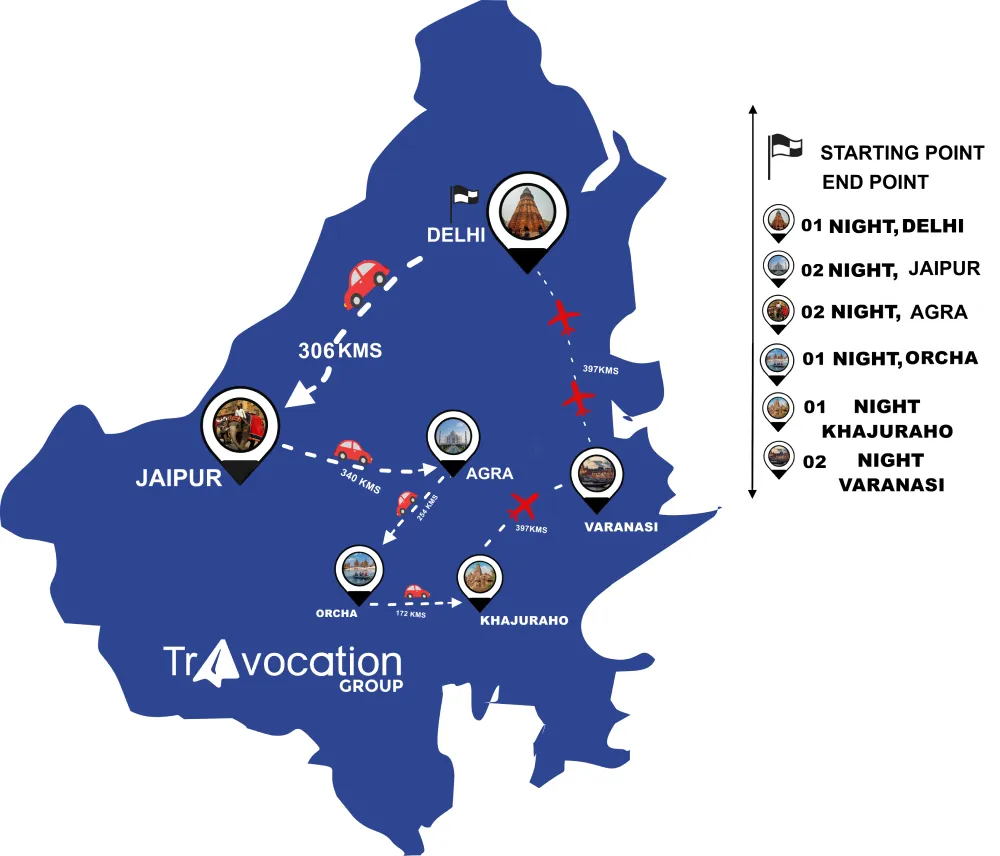

We are Here To Serve You ?
Book With Confidence
- No-hassle best price guarantee
- Customer care available 24/7
- Hand-picked Tours & Activities
- Free Travel Insurance
Detailed Itinerary
Expand allCollapse allArrival & Explore Delhi
This tour starts with your pick up from the airport or any hotel in & around Delhi, Noida & Gurugram. Our Representative will be there to pick you up by private car. Your guided city will start with your visit to the following monuments of Delhi.
Delhi, the capital city of India, is a vibrant metropolis that seamlessly blends a rich historical heritage with the fast-paced dynamics of modern life. With a history dating back to ancient times, Delhi has been a witness to the rise and fall of numerous empires, leaving behind a tapestry of diverse cultures and architectural marvels.
The city is home to iconic landmarks such as the Jama Masjid, India Gate, and Qutub Minar, each narrating a chapter from India's past. The bustling streets of Old Delhi exude an old-world charm, with narrow lanes, bustling markets, and the aromatic waft of street food. In contrast, New Delhi, with its wide avenues and colonial-era architecture, serves as the seat of the Indian government.
Jama Masjid: It is one of the most iconic sites of Old Delhi. This grand mosque was erected in 17th century by 5th Mughal Emperor Shah Jahan when the Mughal capital was moved from Agra to Delhi. 25000 believers can offer prayer at one time in this mosque. This is a beautiful example of Indo Islamic architecture.
Spice Market: Old Delhi’s spice market is located in chandni chowk area is believed to be one of the oldest & biggest spice markets of Asia. A visit to this market is a must & to experience the busy streets & smell the essence of different spices. Enjoy the rickshaw ride to see the busy & narrow lanes of Old Delhi.
Raj Ghat: It is a cremation site of one of the most respected & renowned persons of the world, Mahatma Gandhi (The Great Soul Gandhi). He is a national hero & led many movements against the unlawful practices of British Raj in India before independence.
Humayun’s Tomb: It is believed to be the first garden Mausoleum of India which is the final resting place of 2nd Mughal Emperor Humayun. It was erected in 16th century by his widow Haji Bano Begam. The mausoleum is a beautiful example of fusion of Indo Islamic architecture. This grand mausoleum is standing in the middle of the char bagh Persian style of garden with water channels & fountains. This mausoleum complex is also known as ‘Dormitory of Mughals’ because it has around 150 tombs of the family members of Mughal Emperors.
India Gate: It is a war memorial which was erected in 20th century before independence to honour the martyrdom of 13000 soldiers who lost their lives in the First World War. This huge gateway with a height of 52 metres is built of sand stone & it is a symbol of India.
Bangla Sahib Gurudwara: It is a prominent Sikh house of worship in Delhi, is known for its serene sarovar (pool) and golden dome. Built in the 18th century, it commemorates Guru Har Krishan's stay. The gurudwara serves langar (free community meals) and embodies Sikh principles of selfless service and equality.
Qutub Minar: It is an iconic landmark in Delhi, India, stands as a testament to the capital's rich history. Constructed in the early 13th century by Qutub-ud-din Aibak and later expanded by his successors, this UNESCO World Heritage Site represents Indo-Islamic architecture. The towering minaret, reaching a height of 73 meters, boasts intricate Arabic inscriptions and ornate carvings. Surrounding it are historic structures such as the Quwwat-ul-Islam Mosque and the Iron Pillar. Qutub Minar narrates tales of Delhi's diverse cultural influences, from the Qutub complex's inception as a victory tower to its subsequent repurposing under different dynasties.
Lotus Temple: It is an architectural marvel shaped like a blooming lotus flower. Completed in 1986, it serves as the Bahá'í House of Worship, welcoming people of all faiths. The serene white marble structure stands as a symbol of unity, attracting visitors for its unique design and peaceful ambiance.
Post city tour, you will be drop off to your pre booked accommodation & relax.
You are staying this night in Delhi.
Driven from Delhi to Jaipur & Explore it
Post Breakfast, you will be driven to Jaipur. This journey takes 04- 05 hours with a stop at halfway for refreshments. Upon Arrival, check in to the Hotel & in the early evening you will go out & witness the aarti in the temple.
Birla Temple or Laxmi Narayan Temple: This beautiful temple was constructed in 1988 by the Birla Family, is dedicated to Lord Vishnu & Goddess Laxmi. This temple graces the skyline of Jaipur. Adorned with intricate carvings, it stands as a serene oasis of spirituality amidst the bustling city. Witness the evening aarti ceremony in the temple.
After visiting the temple, come back to the hotel & relax.
You are staying this night in Jaipur.
Jaipur City Tour
Jaipur, often referred to as the "Pink City," is the capital city of the Indian state of Rajasthan. It is known for its rich history, vibrant culture, and stunning architecture. Jaipur was founded in 1727 by Maharaja Sawai Jai Singh II, the ruler of Amber, who decided to build a new capital city. The city was meticulously planned with wide streets and organized blocks. Jaipur is a major tourist destination, attracting visitors from around the world. The combination of historical landmarks, cultural experiences, and vibrant markets makes it a must-visit city in India.
Post breakfast, start your city tour with professional tour guide & visit beautiful sites of Jaipur.
Amber Fort: This majestic fort located in Amer town surrounded with Aravali hills near Jaipur, Rajasthan, is a majestic fortification that echoes the opulence of Rajputana architecture. Built in the 16th century, it showcases a fusion of Hindu and Mughal styles. With ornate palaces, intricate carvings, and panoramic views, Amber Fort stands as a testament to India's regal heritage.
Panna Meena Kund: It is a historic step well near Amer Fort in Jaipur, is a symphony of ancient engineering and aesthetics. Built in the 16th century, its geometrically patterned steps and vibrant hues make it both functional and visually striking. The step well served as a communal gathering place and a source of water in the arid region.
Hawa Mahal or Palace of Winds: It stands as a mesmerizing architectural marvel in Jaipur. Built in 1799 by Maharaja Sawai Pratap Singh, its unique facade with 953 intricately designed windows allowed royal ladies to observe street festivities while maintaining privacy. This five-story honeycomb-like structure is a cultural gem.
Jal Mahal or the Water Palace: This palace is an enchanting architectural gem in the midst of Man Sagar Lake in Jaipur. Built in the 18th century, the palace appears to float on the lake's surface. With its red sandstone and intricate details, Jal Mahal is a captivating testament to Rajput style.
Jantar Mantar or the Observatory: It is an astronomical observatory in Jaipur, is a UNESCO World Heritage Site. Constructed in the early 18th century by Maharaja Sawai Jai Singh II, it houses a collection of architectural instruments for celestial observations. The site showcases the ingenuity of Indian astronomers and stands as a historic testament to scientific achievement.
City Palace: This is believed to be one of the 03 biggest palaces of any royal family in Jaipur. It is a splendid royal complex reflecting a fusion of Rajput, Mughal, and European architectural styles. Constructed by Maharaja Sawai Jai Singh II in the 18th century, it houses museums, courtyards, and palatial structures. The palace stands as a living testament to Jaipur's regal history and cultural richness.
There will be a stop for lunch & shopping in between the sightseeing of Jaipur.
Galta Ji Temple: This Temple is located amid the Aravalli Hills near Jaipur, is a sacred Hindu pilgrimage site also known as the Monkey Temple, it features ancient shrines, kunds (water tanks), and natural springs. The temple complex exudes a tranquil atmosphere, and its natural surroundings attract pilgrims and tourists seeking spiritual solace. In this temple complex, where you will see the human & monkeys takes bath in the same water reservoirs.
After seeing the beautiful sites of Jaipur, come back to the hotel & relax.
You are staying this night in Jaipur.
Driven from Jaipur to Agra
Post Breakfast, check out from hotel & driven to Agra. This journey takes 04 – 05 hours with a stop for lunch at halfway. Enroute stop at
Chand Baoli step well: This step well located in Abhaneri village near Jaipur, is an ancient step well dating back to the 9th century. With 3,500 symmetrical steps leading to the water level, it exemplifies intricate architecture. The well, surrounded by arched corridors, served as a water reservoir and a respite from the desert heat.
Fatehpur Sikri: It is a UNESCO World Heritage Site renowned for its exquisite Mughal architecture. Commissioned by Emperor Akbar in the late 16th century, the city served as the Mughal capital from 1571 to 1585. It is also known as a Ghost Town which has been abandoned since many centuries. This is also the place where the sufi mystic had forecasted the birth of a worldly heir Prince Salim. The site reflects a unique blend of Hindu and Islamic architectural styles, showcasing Akbar's vision of religious tolerance. Despite its short-lived prominence, Fatehpur Sikri remains a poignant symbol of Mughal splendor and cultural synthesis.
Continue driven to Agra, upon arrival in Agra, check inn to the pre booked accommodation & relax.
You are staying this night in Agra.
Agra City Tour
Agra, located in the northern state of Uttar Pradesh, India, has a rich and storied history that spans several millennia.Agra's history can be traced back to ancient times when it was known as "Agravana" or "Agrawana" in Sanskrit literature. It is believed to have been part of the ancient Brijbhumi region, associated with Lord Krishna.It gained prominence during the 16th century as the capital of the Mughal Empire under Emperor Akbar, who built the Agra Fort and initiated the construction of Fatehpur Sikri nearby.Agra has a rich cultural heritage that blends Mughal, Persian, and Indian influences. This heritage is reflected in its cuisine, art, and music, making it a vibrant and culturally significant destination.
Visit Monuments Like
Start your day early at sunrise to visit the Taj Mahal with professional tour guide. After visiting the Taj Mahal, come back to the hotel for breakfast.
Taj Mahal at Sunrise: It is believed to be one of the most beautiful examples of expressing love for a woman. This marble mausoleum was erected in 17th century by 5th Mughal Emperor Shah Jahan for his beloved wife Mumtaz Mahal who died after childbirth. It took 22 years to build. It is something that you must see once in a life as a person.
Agra Fort: The Majestic fort is believed to be the first fort erected by Mughal Emperor in 16th & 17th centuries in their first capital city Agra which was known as Akbarabad. This has huge ramparts, beautiful palaces in red sandstone & white marble, big halls of common & private audiences, Persian form gardens with water channels & fountains. This fort is not to be missed when you are in Agra.
Etimad ud Daulah or the Baby Taj: Often called the "Baby Taj," the Itimad-ud-Daulah's Tomb in Agra, is a masterpiece of Mughal architecture. Built in the 17th century by Nur Jahan for her father, it features intricate marble inlay work and serene gardens. This smaller-scale gem is considered a precursor to the grandeur of the Taj Mahal.
Mehtab Bagh or the Moon light Garden: This beautiful Moon Light garden located across the Yamuna River from the Taj Mahal in Agra, offers breathtaking views of the iconic monument. Built during the Mughal era, it is a charbagh (four-part garden) with lush greenery. The garden is an ideal spot to admire the Taj Mahal's beauty and capture stunning reflections at the sunset.
After visiting the sites of Agra, driven back to the pre booked accommodation & relax.
You are staying in Agra.
Driven from Agra to Orchha & Explore It
After having the luscious breakfast, you will be driven to your next destination i.e., Orchha. This journey takes 03 – 04 hours with a stop at halfway for refreshments. Upon arrival, check in to the hotel & later explore Orchha & it’s beautiful sites.
Orchha, a picturesque town nestled on the banks of the Betwa River in the heart of India, is a hidden gem that embodies the essence of India's rich history and architectural heritage. Orchha is also renowned for its chhatris or cenotaphs, which are elevated, dome-shaped memorials, dedicated to the Bundela rulers. These chhatris, set against the backdrop of the river, create a mesmerizing reflection during the golden hours of the day.
Post Lunch Visit the sites of Orchha
Orchha Fort: This majestic fort nestled on the banks of the Betwa River in Madhya Pradesh, is a captivating medieval marvel. Built in the 16th century by the Bundela Rajput kings, the fort boasts exquisite architecture, including the iconic Jahangir Mahal. Its intricate frescoes and historical significance make Orchha Fort a cultural gem.
Jahangir Palace: This is a splendid palace built in the 17th century for Emperor Jahangir within Orchha Fort. This architectural masterpiece reflects a blend of Mughal and Rajput styles, adorned with ornate domes, intricate carvings, and vibrant frescoes. Jahangir Mahal stands as a testament to the cultural fusion and artistic grandeur of its era.
Cenotaphs or Chhatri of Orchha: The Royal Cenotaphs of Orchha stand as silent tributes to the Bundela rulers of the 17th and 18th centuries. Perched along the serene Betwa River, these intricately carved cenotaphs, also known as Chhatris, commemorate the valor and grandeur of the departed kings and their families. The architectural splendor of these memorials, adorned with domes, spires, and delicate detailing, harmoniously integrates Rajput and Mughal influences. Each cenotaph reflects a unique design, contributing to Orchha's rich heritage.
After sightseeing, come back to the hotel & relax.
You are staying this night in Orchha.
Driven from Orchha to Khajuraho & Explore It
After having the luscious breakfast, you will be driven to your next destination i.e. Khajuraho. This journey takes 03 – 04 hours with a stop at halfway for refreshments. Upon arrival, check in to the hotel & later explore Khajuraho & it’s beautiful sites.
Khajuraho, located in the Indian state of Madhya Pradesh, is renowned for its exquisite group of temples, collectively known as the Khajuraho Group of Monuments. These temples are a UNESCO World Heritage Site and are celebrated for their stunning and intricate erotic sculptures, which are some of the most famous in the world. The history of Khajuraho is fascinating and dates back to the Chandela dynasty, which ruled over the region from the 9th to the 13th centuries.
Post Lunch, start guided city tour of Khajuraho & Visit
Eastern Group of Temples: The Eastern Group of Temples constitutes a remarkable ensemble of Hindu temples renowned for their architectural and sculptural brilliance. Constructed between the 9th and 12th centuries by the Chandela dynasty, these temples showcase exquisite craftsmanship and intricate carvings depicting various facets of life. Notable structures within the group include the Parsvanatha, Adinatha, and Ghantai Temples. These architectural marvels exemplify the rich cultural and artistic heritage of medieval India.
After sightseeing, come back to the hotel & relax.
You are staying this night in Khajuraho.
Fly from Khajuraho to Varanasi
Post breakfast start your city tour & explore western group of temples which are famous for their erotic carvings.
Western Group of Temples: The Western Group of Temples is a masterpiece of medieval temple architecture and a UNESCO World Heritage Site. Built by the Chandela dynasty between the 10th and 12th centuries, these temples exemplify the exquisite artistry of the time. The Kandariya Mahadeva, dedicated to Lord Shiva, stands as the largest and most ornate, adorned with intricately carved sculptures depicting divine deities, mythical creatures, and sensuous figures. Other prominent temples like Lakshmana and Vishvanatha contribute to the ensemble, showcasing the perfect fusion of spirituality and sensuality. The Western Group remains a testament to India's rich cultural and artistic heritage.
After visiting the temples, you will be drop off at Khajuraho airport to catch your flight bound to Varanasi.
Upon arrival in Varanasi, our representative will be there to pick you up & transfer to the Hotel. Evening Aarti of River Ganges: The evening Aarti at Dashashwamedh Ghat, Varanasi, unfolds as a spiritual spectacle along the sacred Ganges. Skilled priests clad in traditional attire perform a mesmerizing ceremony with synchronized chants, rhythmic bell ringing, and the waving of oil lamps against the dusk sky. Devotees seek blessings, and onlookers marvel at the cultural richness. The Ganges, symbolizing purity, adds depth to the ritual. In this profound atmosphere, the Aarti at Dashashwamedh Ghat becomes a captivating blend of devotion and tradition, leaving an indelible impression on all who witness this harmonious convergence of spirituality and spectacle.
After seeing the ceremony, you will be drop off to your hotel & relax.
You are staying this night in Varanasi.
Explore the oldest living City of World - Varanasi
“It is said that you have not seen the soul of India until you have explored Varanasi”.
Varanasi, India's spiritual heart teems with ancient mystique along the sacred Ganges River. Its labyrinthine alleys host vibrant markets, bustling with silk, spices, and devotion. The ghats, stone steps descending to the river, witness rituals, prayers, and cleansing dips in the holy waters. The city echoes with the resonance of temples, showcasing intricate architecture and devout worship. Varanasi's soul thrives in its diverse tapestry of culture, art, and timeless traditions. From the enchanting Ganga Aarti to the tranquil boat rides at sunrise, every moment in Varanasi tells a story, weaving a timeless connection between spirituality, life, and the eternal river.
Start your day early with a boat ride to witness the different activities happen at the several ghats of river Ganges.
Boat Ride at Sunrise: Embarking on a sunrise boat ride in Varanasi is a magical journey into the spiritual heart of India. Drifting along the Ganges River, the golden hues of dawn paint the ancient ghats and temples, casting a serene glow on the sacred waters. As the city awakens, witness devotees performing morning rituals, meditating, and bathing in the holy river. The soft lapping of oars against the current harmonizes with the distant sounds of temple bells and prayer chants. The tranquil spectacle unveils Varanasi's timeless beauty, capturing the essence of a city where spirituality meets the sublime, creating an indelible memory of serenity at sunrise.
Kashi Vishwanath Temple: It is a revered Hindu shrine dedicated to Lord Shiva. It stands as a spiritual beacon on the western bank of the Ganges. The temple, known for its ornate architecture and religious significance, attracts devotees seeking blessings and a profound connection with the divine.
Manikarnika Ghat: Manikarnika Ghat is a renowned cremation site on the sacred Ganges in Varanasi. Hindus believe that cremation here ensures moksha, liberation from the cycle of reincarnation. The ghat bustles with funeral pyres, embodying the cycle of life and death. Pilgrims consider it a gateway to spiritual transcendence and eternal peace.
Assi Ghat: Assi Ghat, nestled along the Ganges in Varanasi, India, is a serene riverfront embankment. Renowned for its peaceful ambiance and cultural significance, Assi Ghat is frequented by pilgrims and seekers. It offers a tranquil retreat for meditation, yoga, and spiritual contemplation, embodying Varanasi's timeless charm and spiritual allure.
Sarnath: Sarnath Stupa is a sacred Buddhist site where Lord Buddha first taught the Dharma located near Varanasi. The stupa, constructed by Emperor Ashoka in the 3rd century BCE, stands as a symbol of Buddhism's origin. Its Dhamek Stupa is an imposing structure, marking the spot where Buddha gave his first sermon. The intricately carved structure houses relics and serves as a pilgrimage site for Buddhists worldwide. Surrounded by archaeological ruins and serene gardens, Sarnath Stupa radiates historical significance and spiritual tranquility, inviting visitors to reflect on the profound teachings that emanated from this hallowed ground.
After the sightseeing, you will be driven back to the hotel & relax.
You are staying this night in Varanasi.
Fly from Varanasi to Delhi
Post breakfast pack your luggage because you will be driven to the airport to catch your flight bound to Delhi.
Upon arrival in Delhi, Our representative will be there to receive you & drop off to your preferred location in & around Delhi for onwards journey.
Tour ends here.

Vehicle we use

Sedan 1-2 Peoples

Suv 3-5 Peoples

Mini Coach 6-12 Peoples
FAQ's
What is the Cancellation Policy?
Does Train ride includes Economy Coach or Executive Coach?
Can i book this tour in advance?
What are the Payment methods?
What is the Pick-Up Location and Drop-Off Location?
real travelers reviews
![Travocation Group]()
 Silvia2025-08-13Respectful friendly and fun!! Shaan, Great tour guide in Delhi, Jaipur and Agra. We visit the most emblematic places and other more secret corners. Hello India Tour highly recommended and very entertaining.
Silvia2025-08-13Respectful friendly and fun!! Shaan, Great tour guide in Delhi, Jaipur and Agra. We visit the most emblematic places and other more secret corners. Hello India Tour highly recommended and very entertaining. German C2025-08-13Quality right price!! I came with quite a lot of expectations regarding India, some fears, traveling with my wife on vacation and I think the best decision was to have hired a local guide and good choice we had when meeting Shaan, I think hello Indian tour is a good choice if you want to have a good experience and care.
German C2025-08-13Quality right price!! I came with quite a lot of expectations regarding India, some fears, traveling with my wife on vacation and I think the best decision was to have hired a local guide and good choice we had when meeting Shaan, I think hello Indian tour is a good choice if you want to have a good experience and care. Blanca Leticia Gastelum Galindo2025-07-30My days EN India Hello my name ES Blanca, I am DE Mexico and it was an excellent experience with Hello India tours with my guide Shaan , I highly recommend it, we went to DE Delhi city, Agra where the Taj Mahal is, Jaipur, Jodhpur, Pushkar .. excel EN te service .. ask my star guide in Spanish 100% Shaan ..🌹😀
Blanca Leticia Gastelum Galindo2025-07-30My days EN India Hello my name ES Blanca, I am DE Mexico and it was an excellent experience with Hello India tours with my guide Shaan , I highly recommend it, we went to DE Delhi city, Agra where the Taj Mahal is, Jaipur, Jodhpur, Pushkar .. excel EN te service .. ask my star guide in Spanish 100% Shaan ..🌹😀 MARIA M2025-07-28Perfect Trip I had an amazing experience with Travocation Group! From the very beginning, their team was professional, responsive, and truly cared about making my trip smooth and memorable. ✨ Whether you’re traveling solo, as a couple, or with a group, I highly recommend Travocation Group for a stress-free and unforgettable journey. Looking forward to planning my next adventure with them!✅ Trusted Company✅ Great Customer Service✅ Value for MoneyThank you, Travocation Group! 🙌
MARIA M2025-07-28Perfect Trip I had an amazing experience with Travocation Group! From the very beginning, their team was professional, responsive, and truly cared about making my trip smooth and memorable. ✨ Whether you’re traveling solo, as a couple, or with a group, I highly recommend Travocation Group for a stress-free and unforgettable journey. Looking forward to planning my next adventure with them!✅ Trusted Company✅ Great Customer Service✅ Value for MoneyThank you, Travocation Group! 🙌 Itsasne C2025-07-25Experience DE 10! The tour has been fantastic. Spectacular places and views, the guide and the driver very attentive with us. 100% recommended.
Itsasne C2025-07-25Experience DE 10! The tour has been fantastic. Spectacular places and views, the guide and the driver very attentive with us. 100% recommended. Ane G2025-07-25Amazing! The tour was amazing. They adapted a bit to what we wanted and it's been great!Both the driver and the guide have been super nice and made us feel great.The guide spoke Spanish perfectly and explained things very well.
Ane G2025-07-25Amazing! The tour was amazing. They adapted a bit to what we wanted and it's been great!Both the driver and the guide have been super nice and made us feel great.The guide spoke Spanish perfectly and explained things very well. pablo V2025-07-22DE Dream Trip and 5-Star Tour Happiness POR the path accompanied EN my aventura in India. I knew many places, I EN you accompanied and protected at all times. DE highlight the guide of Raza who went to find me and leave all the destinations. And DElight the Spanish-speaking guide Musharraf POR his work and history EN station in the different monuments toured. I'll come back more often and with more people. Thank you and congratulations.
pablo V2025-07-22DE Dream Trip and 5-Star Tour Happiness POR the path accompanied EN my aventura in India. I knew many places, I EN you accompanied and protected at all times. DE highlight the guide of Raza who went to find me and leave all the destinations. And DElight the Spanish-speaking guide Musharraf POR his work and history EN station in the different monuments toured. I'll come back more often and with more people. Thank you and congratulations. Javi G2025-07-18Grateful to the willingness of the guide and driver. Overall rating of 10. Programme adjusted to the time available. Right.Perhaps as a suggestion and given the little offer of activities in Agra I would have proposed reducing a night in Agra and adding it to Jaipur or Delhi.
Javi G2025-07-18Grateful to the willingness of the guide and driver. Overall rating of 10. Programme adjusted to the time available. Right.Perhaps as a suggestion and given the little offer of activities in Agra I would have proposed reducing a night in Agra and adding it to Jaipur or Delhi. gemma o2025-07-18A unique experience From arrival at the airport to the end of the trip we have had a magnificent experience. Both the guide and the driver were watching us at all times. They were polite, punctual, helped us choose meals (since we don’t like spicy). Amid, the guide, explained all the monuments and had the patience to take pictures. Overall it was great. We are looking forward to coming back to see other places in India.
gemma o2025-07-18A unique experience From arrival at the airport to the end of the trip we have had a magnificent experience. Both the guide and the driver were watching us at all times. They were polite, punctual, helped us choose meals (since we don’t like spicy). Amid, the guide, explained all the monuments and had the patience to take pictures. Overall it was great. We are looking forward to coming back to see other places in India. Carlos B2025-07-17Vwry good experience Great guide with very good level of Spanish. He took us to visit the Taj Mahal with brief but important explanations. We also visited the small Taj Mahal - It Madud - Daula, among other places and at night we visited the sadar bazaar. Highly recommended
Carlos B2025-07-17Vwry good experience Great guide with very good level of Spanish. He took us to visit the Taj Mahal with brief but important explanations. We also visited the small Taj Mahal - It Madud - Daula, among other places and at night we visited the sadar bazaar. Highly recommended

 English
English Spanish
Spanish

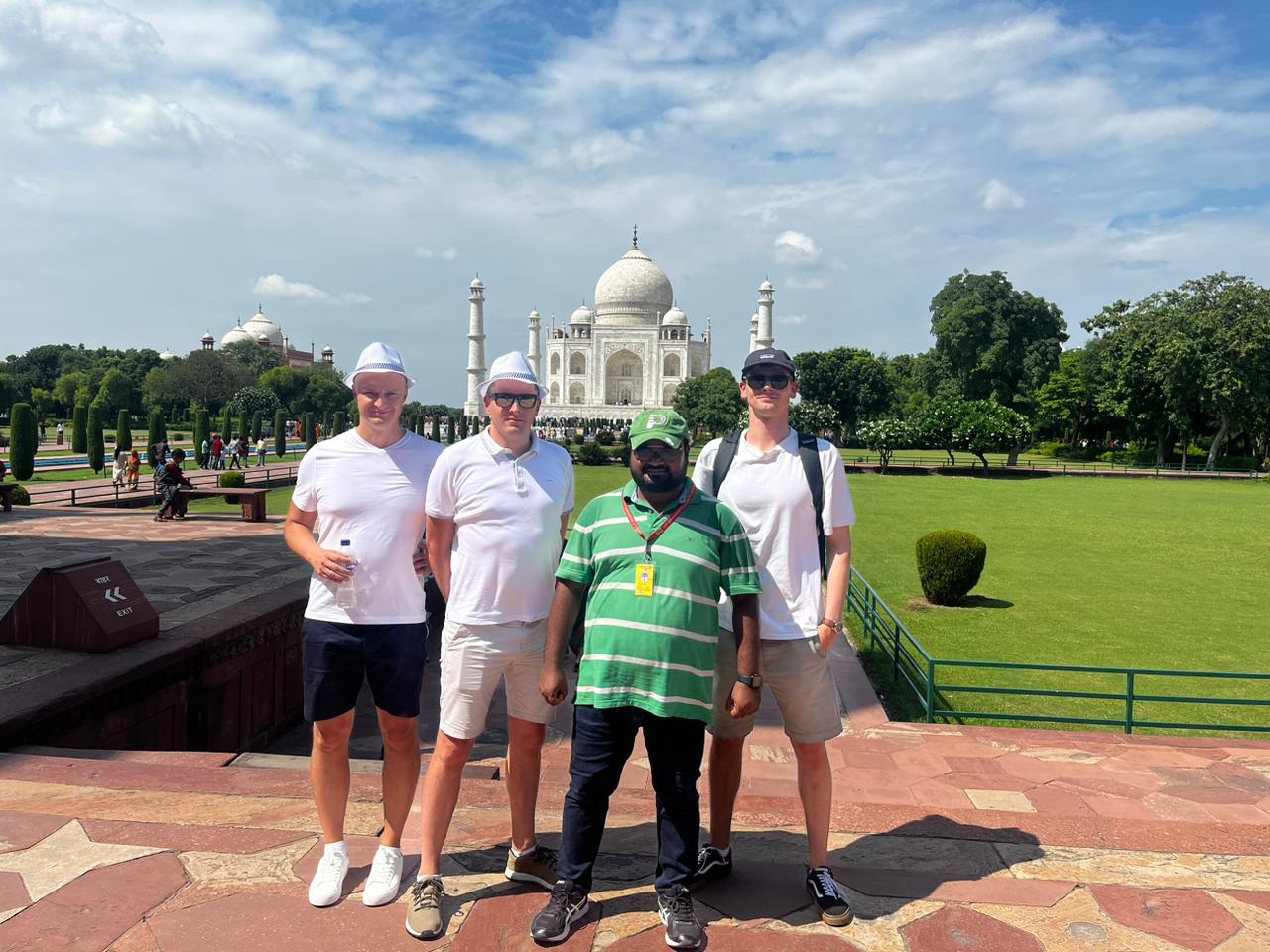
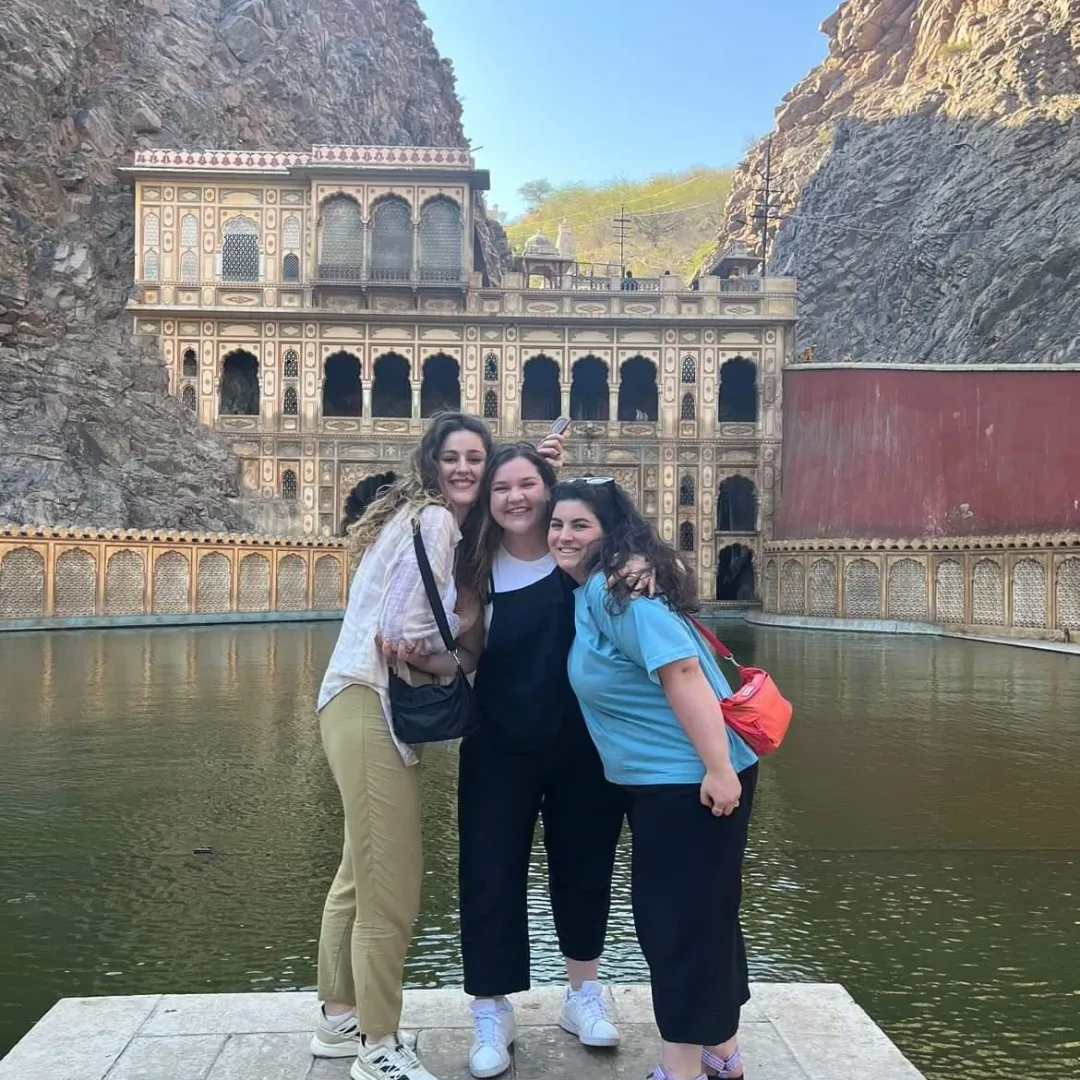
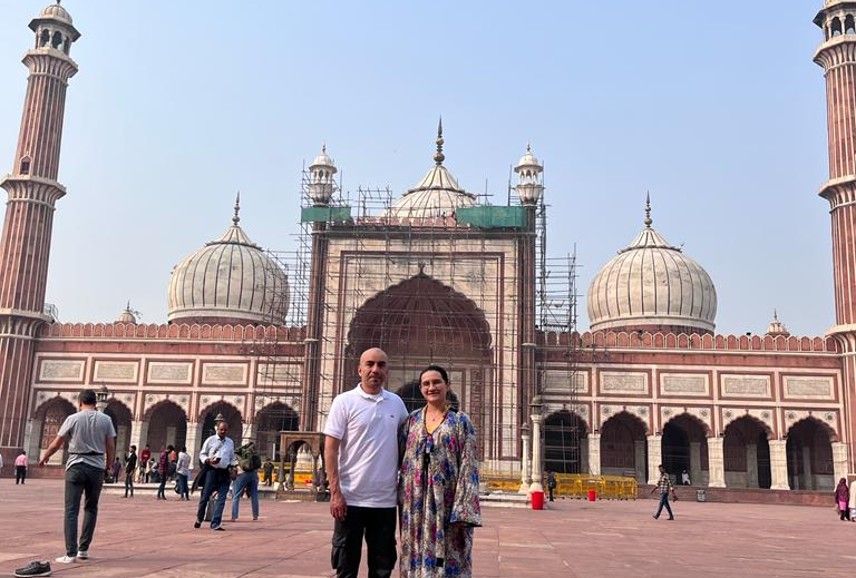
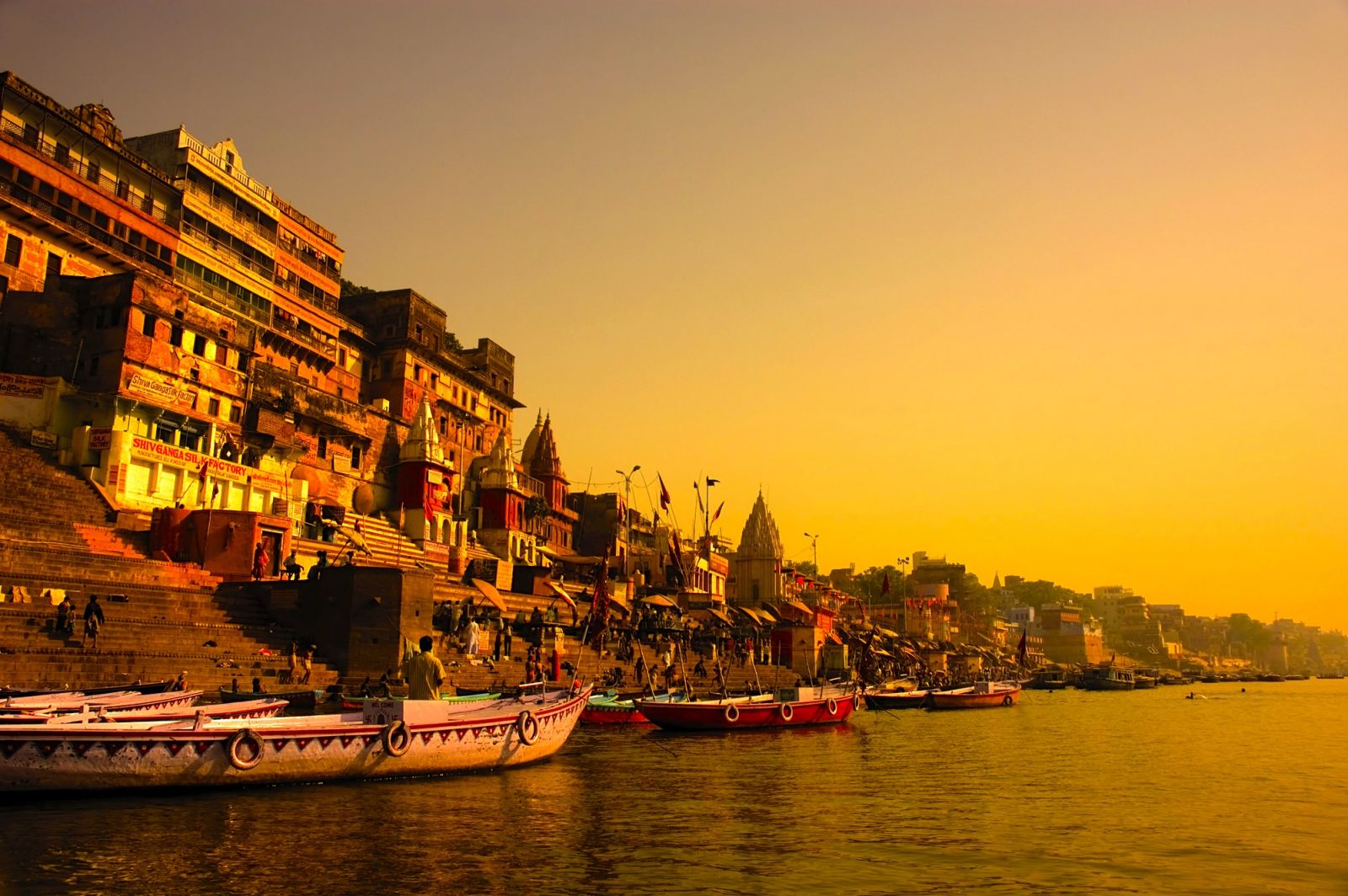


 Book on Tripadvisor
Book on Tripadvisor
 Book on GetYourGuide
Book on GetYourGuide


